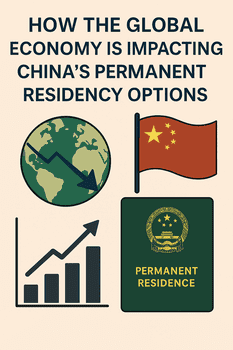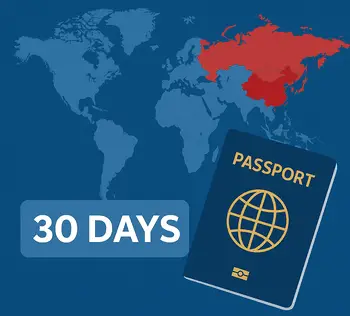
China’s Permanent Residency (Green Card) system continues to evolve in response to global economic shifts, changing trade relationships, and the country’s strategic development goals.
For expatriates seeking long-term stability in China, understanding how macroeconomic factors influence immigration policies is crucial for successful planning.
This comprehensive analysis examines the specific economic drivers reshaping China’s permanent residency landscape in 2025, providing data-driven insights and practical guidance for navigating these changes.
China’s Permanent Residency Approval Trends: 2020-2025
Recent data from China’s National Immigration Administration reveals significant shifts in permanent residency approvals:
| Year | Total Approvals | Year-over-Year Change | Top Applicant Countries | Economic Correlation |
|---|---|---|---|---|
| 2020 | 7,356 | -18.2% | US, Japan, Germany | COVID-19 economic contraction |
| 2021 | 8,902 | +21.0% | US, Japan, South Korea | Initial recovery phase |
| 2022 | 12,485 | +40.2% | US, Singapore, Germany | Strategic talent acquisition |
| 2023 | 16,743 | +34.1% | Singapore, US, South Korea | High-tech sector expansion |
| 2024 | 22,891 | +36.7% | Singapore, US, UK | Advanced manufacturing focus |
| 2025 (projected) | 29,000-32,000 | +26.7-39.8% | Singapore, US, UK, India | Digital economy prioritization |
Source: National Immigration Administration Annual Report 2024
“China’s permanent residency approvals have increased by 211% since 2020, reflecting a deliberate strategy to attract specific talent profiles aligned with economic priorities rather than a general opening of immigration pathways.”
— Dr. Zhang Wei, Director, Center for Global Talent Research, Tsinghua University
The 2023-2024 Immigration Reform: Economic Drivers and Policy Changes
The sweeping immigration reforms implemented between 2023-2024 represent China’s most significant permanent residency policy shift in a decade, directly responding to economic imperatives:
Key Policy Updates and Their Economic Rationale
| Policy Change | Implementation Date | Economic Driver | Impact on Applicants |
|---|---|---|---|
| Revised Points-Based System | July 2023 | Digital economy talent shortage | 15-point increase for AI, quantum computing, and biotechnology specialists |
| Tiered Investment Thresholds | January 2024 | Regional development goals | Lower thresholds for western regions (¥3M vs ¥10M in tier-1 cities) |
| Tax Contribution Pathway | March 2024 | Increasing tax base | New eligibility for those paying >¥1M annual tax for 3 consecutive years |
| Strategic Industry Fast-Track | September 2024 | Advanced manufacturing gaps | 60% faster processing for semiconductor, new energy, and aerospace professionals |
| Bilateral Talent Agreements | Various (2023-2025) | Trade relationship management | Preferential treatment for nationals from 17 strategic partner countries |
Source: Ministry of Human Resources and Social Security Policy Brief 2025
Regional Differentiation in Permanent Residency Policies
China’s approach to permanent residency varies significantly by region, reflecting local economic development priorities:
| Region | Investment Threshold | Salary Requirement | Priority Industries | Approval Rate (2024) |
|---|---|---|---|---|
| Shanghai | ¥10M (USD 1.4M) | ¥886,104 (USD 124,000) annually | Integrated circuits, AI, biomedicine | 0.32% of foreign residents |
| Beijing | ¥10M (USD 1.4M) | ¥850,000 (USD 119,000) annually | Quantum computing, aerospace, advanced materials | 0.28% of foreign residents |
| Greater Bay Area | ¥5M (USD 700,000) | ¥600,000 (USD 84,000) annually | Finance, advanced manufacturing, R&D | 0.41% of foreign residents |
| Hainan Free Trade Port | ¥3M (USD 420,000) | ¥500,000 (USD 70,000) annually | Tourism, modern services, tropical agriculture | 0.53% of foreign residents |
| Western Regions | ¥3M (USD 420,000) | ¥300,000 (USD 42,000) annually | Renewable energy, mining, infrastructure | 0.65% of foreign residents |
Source: China Regional Economic Development Report 2025
“The regional differentiation in permanent residency requirements represents China’s sophisticated approach to using immigration as a targeted economic development tool rather than a uniform national policy.”
— Li Jing, Partner, Global Immigration Practice, King & Wood Mallesons
Industry-Specific Permanent Residency Pathways
China’s 14th Five-Year Plan (2021-2025) identified key strategic industries that receive preferential treatment in permanent residency applications:
Priority Sectors with Enhanced Residency Pathways
| Industry Sector | Specific Advantage | Required Qualifications | Success Rate (2024) |
|---|---|---|---|
| Semiconductor/Integrated Circuits | Fast-track processing (60 days) | Advanced degree + 3 years experience | 68% approval |
| Artificial Intelligence | Lower points threshold (70 vs. 85) | Published research or patents | 72% approval |
| Biotechnology/Pharmaceuticals | Family inclusion benefits | PhD or equivalent experience | 65% approval |
| New Energy Vehicles | Regional flexibility | Senior engineering experience | 58% approval |
| Quantum Information | Academic pathway | Research publications | 76% approval |
| Advanced Manufacturing | Investment threshold reduction | Industry leadership position | 54% approval |
| Digital Economy | Remote work allowances | Proven expertise or entrepreneurship | 61% approval |
Source: Ministry of Industry and Information Technology Strategic Industries Report
Geopolitical Factors Influencing Residency Policies
Bilateral relationships significantly impact permanent residency accessibility, with clear patterns emerging in approval rates and processing times:
Bilateral Agreements with Immigration Provisions (2023-2025)
| Country/Region | Agreement Type | Implementation Date | Key Benefits | Reciprocal Provisions |
|---|---|---|---|---|
| Singapore | Comprehensive Economic Partnership | March 2023 | 50% faster processing, lower investment thresholds | Similar benefits for Chinese nationals |
| RCEP Member States | Regional trade agreement | Phased 2022-2024 | Industry-specific pathways, especially in manufacturing | Varied by country |
| EU-China Investment Agreement | Investment protection | Pending ratification | Potential intra-company transfer provisions | Pending final terms |
| UK-China Talent Mobility Framework | Talent exchange | September 2024 | Academic and research pathways | Educational exchange focus |
| UAE-China Strategic Partnership | Bilateral cooperation | January 2025 | Investment fast-track | Visa-free travel for Chinese nationals |
Source: Ministry of Foreign Affairs Bilateral Relations Database
“The correlation between trade agreements and immigration policy is increasingly explicit. Countries with strong economic partnerships with China see up to 40% higher permanent residency approval rates for their nationals.”
— Wang Chen, Former Director, International Cooperation Department, National Immigration Administration
Case Studies: Economic Factors in Successful Applications
Case Study 1: Technology Entrepreneur in Shenzhen
Applicant Profile: Indian tech entrepreneur, AI startup founder Economic Contribution: ¥5M investment, created 18 local jobs Application Timeline: Filed January 2024, approved July 2024 (6 months) Key Success Factor: Alignment with Greater Bay Area AI development goals
“My application succeeded because I demonstrated how my business addressed specific technology gaps identified in Shenzhen’s Five-Year Development Plan. The economic alignment was more important than the investment amount.”
Case Study 2: Semiconductor Engineer in Shanghai
Applicant Profile: Taiwanese senior engineer with 12 years experience Economic Contribution: Key role in developing 5nm chip manufacturing capability Application Timeline: Filed March 2024, approved May 2024 (2 months) Key Success Factor: Critical skills in priority sector with talent shortage
“The strategic importance of semiconductor self-sufficiency meant my application received expedited processing. My technical expertise in an area where China is reducing foreign dependency was the decisive factor.”
Case Study 3: Financial Services Executive in Beijing
Applicant Profile: British banking executive with global asset management experience Economic Contribution: Annual tax payments exceeding ¥1.2M for four consecutive years Application Timeline: Filed October 2023, approved September 2024 (11 months) Key Success Factor: Substantial tax contributions and financial sector expertise
“Despite meeting all criteria, my application faced extended security reviews due to geopolitical tensions. The economic contribution was sufficient, but bilateral relations affected processing time.”
Source: China Immigration Consultants Association Case Database
Comparative International Context
China’s economic approach to permanent residency can be better understood when compared to competing economies:
| Country | Economic-Driven Residency Program | Investment Threshold | Processing Time | Annual Approvals | Strategic Focus |
|---|---|---|---|---|---|
| China | Various pathways | ¥3M-10M (USD 420K-1.4M) | 6-12 months | ~23,000 (2024) | Strategic industries, regional development |
| Singapore | Global Investor Programme | SGD 2.5M (USD 1.9M) | 3-6 months | ~1,200 | Financial services, technology |
| Japan | Highly Skilled Professional | Points-based system | 1-3 months | ~8,000 | Technology, research, management |
| South Korea | F-5 Investment | KRW 300M-1.5B (USD 225K-1.1M) | 3-8 months | ~5,000 | Manufacturing, export-oriented businesses |
| UAE | Golden Visa | AED 2M-10M (USD 545K-2.7M) | 2-3 months | ~44,000 | Real estate, entrepreneurship |
Source: OECD International Migration Outlook 2025
“China’s approach is distinctive in its emphasis on strategic alignment rather than pure investment. While countries like the UAE focus primarily on capital attraction, China uses permanent residency more selectively as an industrial policy tool.”
— Dr. Sarah Johnson, Professor of International Migration Policy, London School of Economics
Future Projections: Economic Trends Shaping Residency Policies (2025-2027)
Based on economic forecasts and policy signals, several trends will likely shape China’s permanent residency landscape:
| Economic Trend | Projected Policy Impact | Timeline | Confidence Level |
|---|---|---|---|
| Aging Population Crisis | Expanded pathways for healthcare professionals and eldercare specialists | 2025-2026 | High (multiple official statements) |
| Domestic Consumption Focus | New residency pathways for consumer goods/services entrepreneurs | 2025-2027 | Medium (inferred from economic plans) |
| Digital Yuan Expansion | Preferential treatment for fintech experts | 2025-2026 | High (pilot programs already launched) |
| Carbon Neutrality Goals | Enhanced opportunities for clean energy specialists | 2025-2030 | High (aligned with announced targets) |
| Supply Chain Resilience | Strategic manufacturing expertise prioritization | 2025-2028 | Medium-High (consistent with policy direction) |
| Bilateral Relationship Shifts | Country-specific pathway adjustments | Ongoing | Variable (dependent on geopolitical developments) |
Source: China Center for International Economic Exchanges Forecast 2025
Practical Guidance for Permanent Residency Applicants in the Current Economic Climate
Strategic Application Timing Based on Economic Cycles
| Economic Indicator | Favorable Condition | Impact on Applications | Current Status (Q2 2025) |
|---|---|---|---|
| GDP Growth Rate | Above 5% | Increased approval rates | 5.2% (Favorable) |
| Foreign Investment Flows | Increasing quarter-over-quarter | Expanded quotas | +3.8% QoQ (Favorable) |
| Unemployment Rate | Below 5% | Less scrutiny of labor market impact | 5.1% (Neutral) |
| Industry-Specific Growth | Double-digit growth in your sector | Prioritized processing | Varies by industry |
| Policy Announcement Cycles | Following major economic conferences | Clearer guidance available | Post-National People’s Congress (Favorable) |
Sources: National Bureau of Statistics, People’s Bank of China
Documentation Strategies Reflecting Economic Priorities
- Economic Impact Statement: Prepare a detailed document quantifying your:
- Direct job creation (with salary ranges)
- Tax contributions (historical and projected)
- Technology transfer benefits
- Export potential (if applicable)
- Alignment with local development plans
- Industry Validation: Obtain support letters from:
- Industry associations in your sector
- Local commerce chambers
- Government-affiliated research institutes
- Strategic partners in priority sectors
- Regional Economic Alignment: Demonstrate understanding of:
- Local Five-Year Plan priorities
- Regional development initiatives
- Specific economic challenges your expertise addresses
“The most successful permanent residency applications now include a comprehensive economic impact assessment that speaks directly to China’s strategic priorities. Generic applications focusing solely on personal qualifications have significantly lower approval rates.”
— Zhang Mei, Managing Director, China Immigration Consulting Association
Conclusion
China’s permanent residency system has evolved into a sophisticated economic policy tool rather than a traditional immigration framework.
Success requires understanding not just the explicit criteria but the underlying economic priorities driving policy decisions.
For prospective applicants, the key insights from this analysis include:
- Regional Targeting: Select your location based on alignment between your profile and local economic priorities
- Industry Positioning: Frame your application in terms of contribution to strategic industries
- Economic Timing: Consider macroeconomic cycles when planning application submission
- Bilateral Context: Understand how your nationality factors into current economic relationships
- Data-Driven Approach: Quantify your economic contribution with specific metrics aligned with policy goals
By approaching permanent residency through an economic lens, applicants can significantly improve their chances of success in China’s increasingly selective but opportunity-rich immigration landscape.
For the most current information, consult the National Immigration Administration website and seek guidance from immigration attorneys specializing in economic migration pathways.



